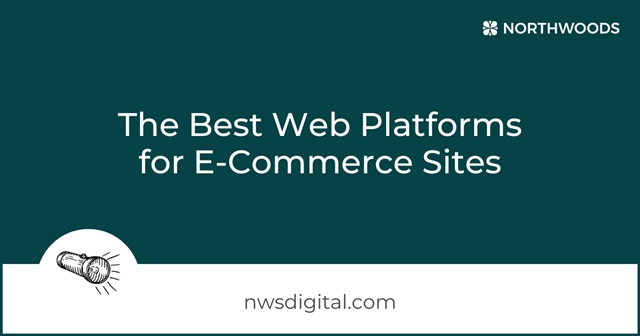By Northwoods Team
November 29, 2023
4 Minute Read
After years of work coming up with a great product to sell online, you hurry to pop up a website and wait for the orders to roll in.
And then they don’t. Your site fails to draw the traffic your product deserves. You expected your website to rank #1 on Google for searches related to your product and its benefits for purchasers. Instead, it’s buried several pages down.
The lesson in this: Google rankings don’t happen by magic. They flow from intelligent effort put into search engine optimization (SEO).
We’re here to help with the following recommendations. The time investment could pay big dividends in the long run. Likely buyers who hadn’t heard of you will find you. Site traffic will rise, and conversions will jump.
Let’s get started!
Start with Great Product Descriptions
Product descriptions are key drivers of basic SEO traffic. An enticing, distinctive product description sells better than a dry, run-of-the-mill description.
Consider:
Option 1: “This Northern Candle is pine scented. It’s made from soy wax. It burns for 40 hours.”
Option 2: “Our Northern Candle is a pine scented candle, handcrafted with soy wax. Our soy wax candle can fill your home with a delightful aroma for over 40 hours.”
In option 2, not only have we made the description more compelling to read, but we also included keywords (pine scented candle and soy wax candle). This keyword placement will help optimize these target keywords on Google search.
Make sure that your product descriptions are unique. You might have similar products and be tempted to copy-paste and then swap in a couple of words. Google takes notice and will knock your search rankings for that. Also a no-no: copying and pasting the manufacturer's description of the product. This applies to drop-shipping e-commerce sites. Unique descriptions aligned with your brand will set you apart from competitors who take the cut-and-paste shortcut.
Structured Data & Schema.org Markup
Along with writing compelling descriptions, include such product attributes as title, colors, pricing, availability, shipping details and bulk discounting.
Google loves structured data – product pages, for example. Google’s bots crawl and index them easily, because the data is organized the same way on each page. You can enhance your product pages with schema.org markup to further assist Google in understanding the structure of your pages. (Follow the link for more about that.)
In addition to schema.org markup, Google offers a feature for uploading your product data to Google Merchant Center, which is basically a database of your products and their attributes. It allows Google to display your products in rich snippets on search results pages and feeds any shopping or Performance Max campaigns you run in Google Ads. (Learn more about completing the Google Merchant Center upload.)
Keywords: The Deeper Story
Less is more when it comes to keywords. Targeting dozens of keywords on every page can leave you nowhere. Instead, identify one or two keywords for each page, and craft descriptions, links, tags, and alt text around those words. Google Keyword Planner can be a great starting point for research.
Next, balance search volume and competition density. Some words might have a large search volume; theoretically, that makes them ideal. But competition density can make it hard to rank. To circumvent this problem, pick keyword phrases or identifying intent keywords.
Weave keywords into other SEO strategies, such as alt text for images, anchor text, and URLs. Alt text for images can play a critical role in making your product images display in Google Image searches. Many users search for images of products; when your product places at the top of an image results page, sales can follow. The alt text and thoughtfully layered keywords can go a long way.
Give some thought to link anchor text. Many content writers take the easy way out: “Click here for details.” Better: “Click to read our helpful essential candle guide.” Both link to the same article, but the second layers in the candle guide keyword and raises the likelihood of click-through.
Put thought into your URL, which can help Google understand your pages and users.
Don’t stuff keywords into a URL if they don’t make sense, but your product name should be part of it. Google recommends making clear URLs for indexing and user experience. Product numbers often appear in URLs, like this: /product/3456. Bad idea. Google doesn’t understand what this product number is in relation to the keyword. It’s better to include keywords in your URL, like this:/product/northern-candle. You can also create a URL with a combination of the product number and the keyword.
User Experience Is King
What to do for SEO beyond keywords?
- Optimize for mobile.
- Create quality content.
- Optimize images.
- Have a stable, quality host for your website.
- Run regular updates on your site.
- Routinely check for broken links and old content.
And there’s more:
Google recommends internal links to promote featured products and pages. These links help Google determine the quality and importance of a page via linkage within the site. Link your newsletter, blog, and other product pages to a featured page or product. These links lengthen user dwell time and deepen engagement on the site, and they raise the site’s importance in the all-seeing eyes of Google.
All this boils down to spending time and effort early in your e-commerce journey, to set a solid foundation. Working through each of the above sections will position your site for success. Many of these items are low hanging, but often overlooked, fruits.
Some of these tips and tricks lend themselves to DIY. But some don’t. When it comes to the more technical aspects, such as structured data, the expert team at Northwoods is ready to help. Reach out to us to get started!
Related Blog Posts

With the e-commerce industry anticipated to top $1 trillion in revenue and account for 20% of all U.S. retail sales in 2024, it's critical for e-commerce businesses to build effective, user-friendly websites. Get started with our 10-step guide!

We’ve broken down some of the most popular e-commerce tools by usability, scale, and technical capacity so you can make the best choice for your business.

If you've already mastered online catalogs and carts, and target shopping ads at defined cohorts of customers, social commerce may be your next step. Here's why and how to determine if social commerce is right for your business.